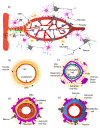The Neurovascular Unit Dysfunction in Alzheimer's Disease
- PMID: 33670754
- PMCID: PMC7922832
- DOI: 10.3390/ijms22042022
The Neurovascular Unit Dysfunction in Alzheimer's Disease
Abstract
Alzheimer's disease (AD) is the most common neurodegenerative disease worldwide. Histopathologically, AD presents with two hallmarks: neurofibrillary tangles (NFTs), and aggregates of amyloid β peptide (Aβ) both in the brain parenchyma as neuritic plaques, and around blood vessels as cerebral amyloid angiopathy (CAA). According to the vascular hypothesis of AD, vascular risk factors can result in dysregulation of the neurovascular unit (NVU) and hypoxia. Hypoxia may reduce Aβ clearance from the brain and increase its production, leading to both parenchymal and vascular accumulation of Aβ. An increase in Aβ amplifies neuronal dysfunction, NFT formation, and accelerates neurodegeneration, resulting in dementia. In recent decades, therapeutic approaches have attempted to decrease the levels of abnormal Aβ or tau levels in the AD brain. However, several of these approaches have either been associated with an inappropriate immune response triggering inflammation, or have failed to improve cognition. Here, we review the pathogenesis and potential therapeutic targets associated with dysfunction of the NVU in AD.
Keywords: Alzheimer’s disease; amyloid peptide; astrocytes; blood-brain barrier; microglia; tau protein.
Conflict of interest statement
The authors declare no conflict of interest.
Figures



References
Publication types
MeSH terms
Substances
LinkOut - more resources
Full Text Sources
Other Literature Sources
Medical

